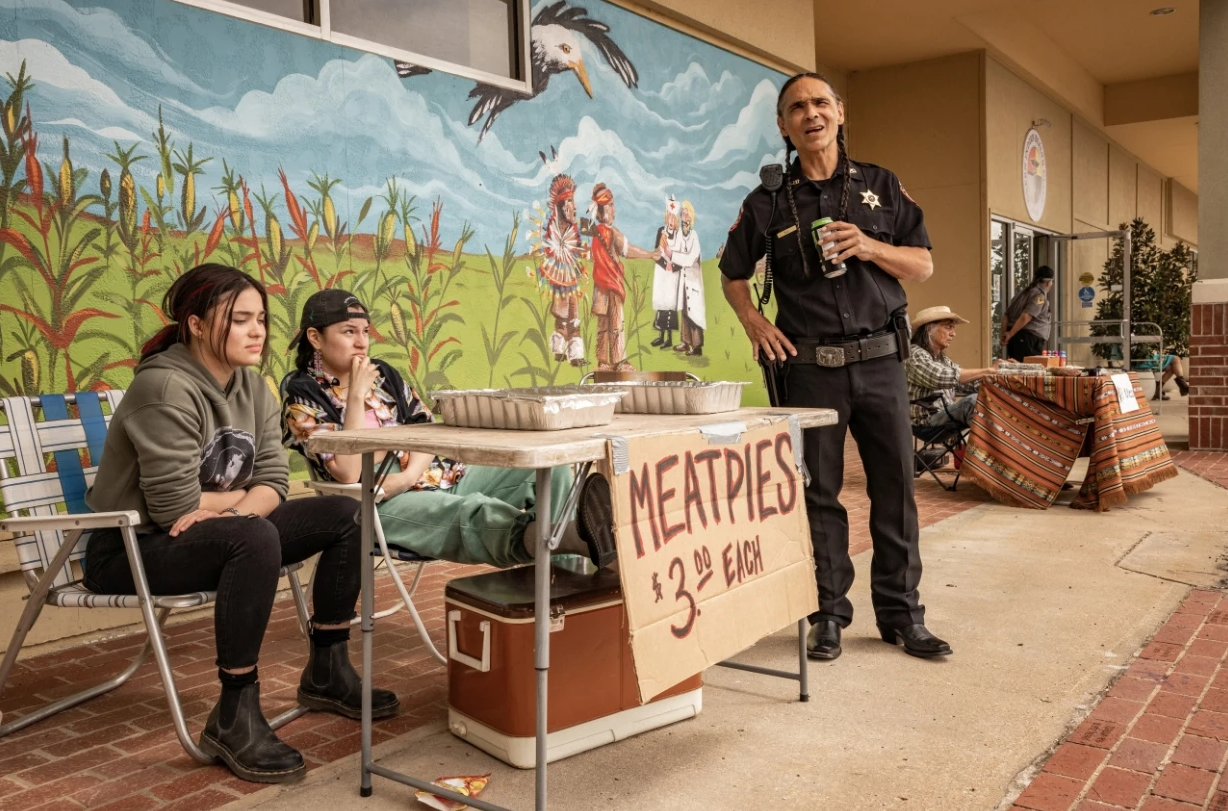Tell Lives, Not Legends
Photo Illustration by Nathan Graber-Lipperman
Now more than ever, viewers want to form real connections through stories. To build long-lasting worlds as creators, it’s on us to optimize for impact over attention.
Co-written by Karim Noorani and Nathan Graber-Lipperman, Essay 3.1 drops on our YouTube channel soon — you can subscribe to get notified as well as read the script below.
Here’s a couple lines of dialogue from one of the most critically-acclaimed television shows in recent memory:
Character 1 [talking to camera]: “The next man who walks in here is getting ridden to death.”
[Pauses, turns around to see Character 2 enter shop]
Character 1: “Dad!?”
Character 2: “Hey!”
Character 1 [to camera]: “Not ideal.”
Fleabag lives in rarefied air, as its second season received 11 Emmy nominations, winning six. But then, at the height of its powers, the show simply…ended, satisfied with its twelve-episode arc.
So what can we learn from creators like Phoebe Waller-Bridge and Emma Chamberlain in telling evergreen stories, stories that help our worlds stand the test of time?
Part I — Defining A Voice
Last season, we focused on how we as creators can build businesses for the long run. We covered a lot of ground, from combating loneliness and setting sustainable foundations; to practicing our craft and providing value to key stakeholders; to laying out the modern roadmap for success on YouTube.
Nevertheless, if we come back to our Season.1 Finale, “An Intro to World-Building,” we’ll remember J.R.R. Tolkien’s message. Before you tell your story, first, you need to make your map.
So, now that the wheels are in motion and we’re building our worlds, what’s next?
The best way to foster a relationship with our audiences is through a strong voice. This manifests itself in different mediums, from writing essays to memorizing scripts to storyboarding a message and translating it visually.
Defining a voice comes more naturally to some than others. Nevertheless, a good starting point is to ask ourselves, What do I have to say, and how do I want to say it?
From there, we want to hook people in. This is often a stylistic thing – for example, if you watch our videos, you’ll notice we start with a case study of our subject as a lens to approach the overarching thesis.
It can also be more practical. Given shorts are a great way to get discovered right now, some of the best creators are phenomenal at positioning quick-hitting vertical videos as teasers for their longform content.
But once we’ve determined our creative purpose and distinguished packaging, we need to focus on telling stories that continuously draw fans into the world we’ve meticulously built up until this point. And the best way to connect with your community is through a universal language – human nature.
In other words, this means sharing the themes, ideas, or values we wish to present through our characters.
Part II – Meandering Storytelling
In recent years, there’s been a notable shift on prestige TV towards what we like to call “meandering storytelling.” Popularized by FX shows like Atlanta, Reservation Dogs, and Dave, this narrative format is a stark contrast from the sitcoms many of us grew up with.
On the one hand, it signifies a change in production style. The aforementioned shows are referred to as “single-cam” – meaning they’re scripted and shot similar to movies – versus their more traditional foil, “multi-cam” – think live studio audience and various camera angles capturing multiple takes at once.
Reservation Dogs, a comedy series about four Native American teens growing up on a reservation in Oklahoma, boasted a strong first season (FX)
On the other hand, it’s an innovative approach to how we structure our plots. Some of the brightest creators forgo a clear-cut beginning, middle, and end, opting out of the tried-and-true template in favor of an in-depth exploration. Through this, we’re immersed in the story as if we’re standing right next to the characters, learning more about them and ourselves as the journey unfurls.
That’s what this vignette-driven model is so good at. The actual trajectory of the characters develops in the background – a lot of the time, we don’t actually get to see the supposed noteworthy milestones. Instead, we’re hyper-focused on the growth to be found during the journey rather than prioritizing an arbitrary finish line.
Now, not all viewers – and creators themselves – necessarily enjoy this type of storytelling. To some, they feel like nothing really happens, there’s no real “plot,” and it could use a lot more exciting set pieces and in-your-face action sequences.
The thing is, though, by now, we’ve all seen the fairy-tale endings, the formulaic fables that feel like they were concocted in a lab. Our popular culture is steeped in them. The reason this newer batch of “meandering stories” are so pervasive is because they’re more gritty, more sobering, a reflection of real life where everything doesn’t necessarily work out for our characters in their search for direction.
Which brings us to Fleabag.
Part III – Substance Without Conflict
Nominated for dozens of awards and named one of the best shows of the 2010s by multiple outlets, both seasons of Fleabag scored 100% on Rotten Tomatoes. It was beloved by fans, too: While Amazon doesn’t report viewership numbers on its streaming service, 2.5 million people tuned into the series finale on the BBC alone.
The show finds its writer, Phoebe Waller-Bridge, starring in the title role, as she makes her way through London’s modern dating scene as a free-spirited young woman running a small cafe. It starts on a wickedly smart and laugh-out-loud funny note, as we’re drawn into Fleabag’s fast-paced life from hookup to hookup.
But as the series progresses, the audience slowly catches on to the fact that the humor is a way for Fleabag to hide the less glamorous and often traumatic moments from her past. When talking about her character, Waller-Bridge told Vulture:
“She’s trying to keep up the jokes, but the tragedy starts revealing itself through the story.”
Phoebe Waller-Bridge, pictured breaking the fourth wall in the scene recapped in our intro (Amazon Prime Video)
What’s so enthralling is the way in which Waller-Bridges decides to tell that story. We’ve broken these key components into three distinct buckets.
First, the runtime. Fleabag is shorter than what we’ve grown to expect from a limited series. The average episode length is around 25 minutes, which would be on the longer end for a vlog – but not unheard of.
Second, the pacing. Even though – similar to some of its contemporaries – there’s effectively no plot, a lot happens in between each cold open and the subsequent end credits. The show is filmed with a quick tempo and sense of purpose, succeeding without a conflict-of-the-week that needs to be tidily resolved.
Third, the narrator. From the beginning, Waller-Bridge is phenomenal as she breaks the fourth wall, often confiding in the audience with her trademark smirk. This element is less a cheap trick and more a vital technique essential to the story, as it allows her to continue feigning control over the narrative for as long as she can (more on that later).
Take these three components in a vacuum. When we look a little closer, there’s a lot of parallels between the show’s core tenants and the type of content a premier YouTube creator might publish.
So how can we implement them into our own worlds?
Part IV – Retrain The Audience
As we talked about in Part I, the best way to draw fans in is through a strong voice.
But that’s not what this essay is about. No, this essay is about how we can get our community members to keep coming back, time and time again, as their relationship to our world evolves in new ways. And in order to do this, as storytellers, we need to form an emotional relationship with our audience.
In this regard, the importance of vulnerability cannot be understated. Yes, it’s daunting at times to share our struggles with our peers, going against the picture-perfect image we’re often encouraged to put on. Yet once we get over that hump, we realize that the exploration of those insecurities is the most effective way to genuinely connect with each other as humans.
This is brilliantly woven into the fabric of Fleabag. Our main character quips directly to us as a way to mask her pain, but it’s only until “The Priest” sees right through her act – questioning who Fleabag is talking to in Season 2 – that she’s able to open up and fall in love.
It’s also why we care so much about creators like Emma Chamberlain. Similar to spending time with Fleabag in her cafe, we’ll watch 15-minute videos of Emma making coffee in her kitchen because we get to know who she is through a seemingly mundane task.
Chamberlain pictured making coffee in one of her beloved vlogs (Emma Chamberlain on YouTube)
Imperfections and idiosyncrasies become a feature, not the first thing out on the cutting room floor. Even though the creator is getting bigger than ever (love ya, Jack Harlow), we can’t stop coming back to her kitchen, revisiting that point in her life and what it means to us as a viewer both then and now.
It takes time to master the three key components we’ve identified – how long to let community members into our worlds, how much to show them, and how we want to say it. But here’s the thing: Nowadays, you don’t need a fancy contract with a streaming service to workshop your personal sweet spots. The internet is our playground, so we might as well take some bumps along the way.
And sometimes, like Waller-Bridge did with Fleabag, that means experimenting and producing our own limited series, then taking a pause before pursuing our next project. If your content is based around you and your personality, then we do have to acknowledge the elephant in the room, as there’s a real pressure to constantly upload when your continuous appearance is the core piece of your media business.
Nevertheless, there’s never been more access and more tools that enable communities to come together in supporting the people and projects they believe in. While it’s a leap of faith, we believe that – in a sense – it’s on us as creators to retrain our audiences to expect a deeper impact from each vignette we craft, then deliver on those promises at a pace sustainable for us.
To quote the wizened Stark matriarch from Game of Thrones, Old Nan:
“Old stories are like old friends…you have to visit them from time to time.”
Therefore, we should celebrate our creators, their stories, and our relationships to them for what they are – not what they’re not.
Coverage from Creator Mag.3 continues on! Plus, catch our video essays by subscribing to our channel and follow along with Karim’s work here.





